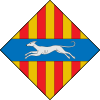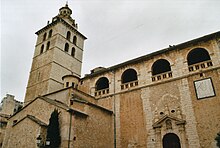Inca
| Inca municipality | ||
|---|---|---|
| coat of arms | Map of Spain | |

|
|
|
| Basic data | ||
| Autonomous Community : | Balearic Islands | |
| Island: | Mallorca | |
| Comarca : | Raiguer | |
| Coordinates | 39 ° 43 ' N , 2 ° 54' E | |
| Height : | 120 msnm | |
| Area : | 58.65 km² | |
| Residents : | 33,319 (Jan 1, 2019) | |
| Population density : | 568.1 inhabitants / km² | |
| Postal code : | 07300 | |
| Municipality number ( INE ): | 07027 | |
| Nearest airport : | Palma ( Son Sant Joan / Palma de Mallorca , 25 km ) | |
| administration | ||
| Official language : | Catalan , Castilian | |
| Mayor : | Virgilio Moreno ( PSOE ) | |
| Address of the municipal administration: | Plaça Espanya, 1 07300 Inca |
|
| Website : | www.ajinca.net | |
| Location of the municipality | ||
Mallorca
|
||
Inca is a municipality on the Spanish Balearic island of Mallorca .
geography
location
The approximately 59 km² large community is located in the Regiron Raiguer , on the southeastern slopes of the Serra de Tramuntana . It is around 30 kilometers to the island's capital, Palma , to the southwest and about 25 kilometers to Alcúdia in the northeast.
history
The first settlements date from the time of the Talayot culture (13th to 2nd centuries BC), these were later inhabited by the Romans when they occupied the island. During the Moorish era the city was known as 'Inkán'.
Population development
Inca has 33,319 inhabitants (as of January 1, 2019). The core city had 27,478 inhabitants in 2008. In 2006, the proportion of foreigners in the municipality of Inca was 14.6% (3,977), the proportion of German residents 0.5% (136).
| year | 1857 | 1877 | 1897 | 1910 | 1930 | 1950 | 1970 | 1991 | 2011 | 2017 |
| Residents | 5,925 | 6,823 | 7,364 | 8,353 | 10,398 | 12,522 | 16,930 | 20,415 | 30,359 | 31,255 |
politics
Twin cities
Inca has two twin cities : Telpaneca in the Madriz Department in Nicaragua and Lompoc in the US state of California .
economy
The region of the Raiguer and in particular the city of Inca are known as the center of the shoe and leather craft in Mallorca. The shoemaker's guilds are the oldest in Mallorca and date back to the Catalan conquest of the island in the 13th century. The leather and shoe trade has developed into industrial companies with an international reputation in this city: Lottusse , George’s , Camper , Barrats , Farrutx , Munper , Asinca and Kollflex are just a few well-known examples.
traffic
Rail transport
Inca has had a train station since 1875. At the beginning this was the terminus of the Palma – Inca line, later the line was built on towards Manacor and Sa Pobla . The train station in Inca developed into one of the most important train stations for passenger traffic and cargo handling. However, it was not affected by the closure of various railway lines on Mallorca in the 1960s, but the volume of traffic fell. Only with the modernization in the 1990s and the electrification in 2012 was the offer again more attractive and more popular.
Today's Inca train station is located southwest of the old town and has three platform tracks that are used for scheduled passenger traffic. From there you can travel three times an hour to Palma and once an hour to Manacor and Sa Pobla.
Road traffic
Inca is located on the Autopista Ma-13 from Palma to Alcúdia and is therefore well connected to the road network of the island of Mallorca. A large number of other country roads lead to all parts of the island.
From the central bus station near the train station and a few other bus stops , buses run to the surrounding area and to the major tourist centers.
Culture and sights
Buildings
- Parish Church of Santa Maria la Major d'Inca is a typical Baroque church on the island of Mallorca. Shortly after the conquest of Mallorca, the simple parish church of Santa Maria d'Inca was built in 1248. The current church of Santa Maria la Major (18th century) is the third place of worship built on this site.
- Convent de Sant Domingo, Dominican monastery
- Church of Sant Francesc
- Wax museum Museo de cera
Regular events
- The market and agricultural fair the Fira "Dijous Bo" (German: Fat Thursday) with often more than 100,000 visitors, takes place on the 2nd Thursday in November.
Personalities
- Gabriel Llompart y Jaume Santandreu (1862–1928), Catholic clergyman; was born in Inca
- Gabriel Buades i Pons (1903–1938), politician, Spanish pacifist and victim of the repression during the Franco era during the civil war; was born in Inca
- Günther Bollhagen (1927–2014), German radio broadcaster, presenter and composer; died in Inca
- Gabriel Busquets Aparicio (* 1950), Spanish diplomat
- Pere Pou i Llompart (born 1963), Spanish singer; was born in Inca.
Web links
- Municipal administration website (Catalan, Spanish)
- Informació de l'Institut d'Estadística de les Illes Balears - data sheet
Individual evidence
- ↑ Cifras oficiales de población resultantes de la revisión del Padrón municipal a 1 de enero . Population statistics from the Instituto Nacional de Estadística (population update).
- ↑ Network map of the bus transport Mallorca of the transport association TIP (Transport de Illes Balears)


